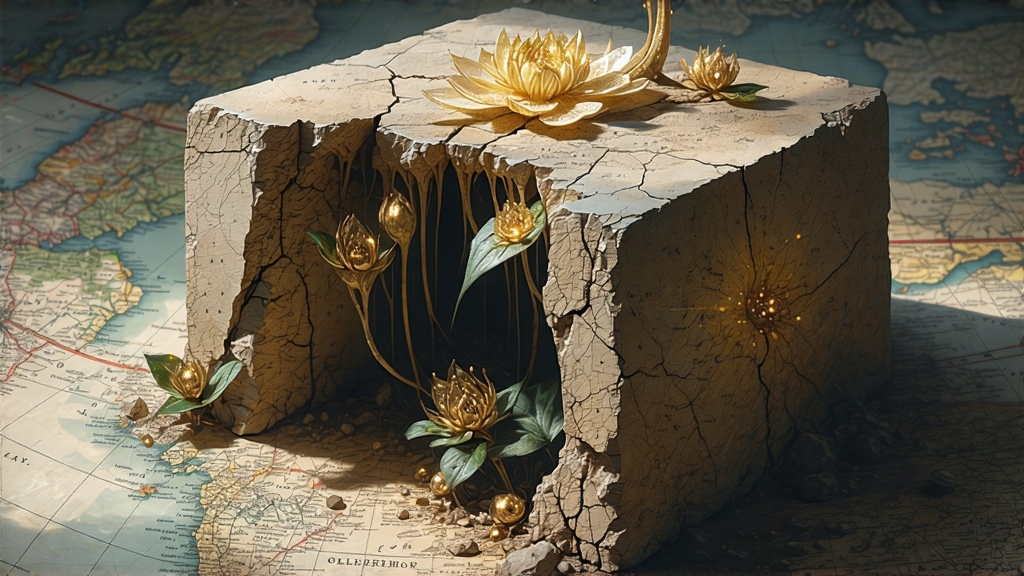
Among the six great families of Chinese tea, dark tea—hei cha—remains the most enigmatic to Western palates. Within this shadowed lineage, Fu brick tea (Fuzhuan cha) stands out as the only variety whose finished appearance is judged not merely by leaf grade or vintage, but by the density of tiny, canary-yellow flecks that bloom inside the brick like flecks of gold. These “golden flowers” are in fact living spores of Eurotium cristatum, a beneficial mold that alters chemistry, flavor, and even the tea’s legendary ability to ease digestion after heavy meals. To understand Fu brick is to travel from the horse-caravan trails of the Tang dynasty to the modern laboratories of gut-health research, all while holding a single, fragrant slice of fermented tea.
1. Historical footprints along the tea-horse road
Fu brick tea first appeared in the Jingyang county of Shaanxi province around 1368, the first year of the Ming dynasty. At that time, the imperial court had just replaced the loose-leaf tribute system with compressed bricks to reduce shipping weight along the Tea-Horse Road. Caravans carrying Tibetan warhorses southward needed compact, slow-fermenting cargo that could survive six-month journeys across the Qinghai-Tibetan plateau. Local tea masters discovered that steaming crude maocha, packing it into long cloth bags, then compressing it under 50-ton screw presses encouraged a secondary fermentation. When the bricks were unloaded in Lhasa, traders noticed a yellow dusting inside the broken sections. Rather than a defect, the bloom—later named “huā” (flower) for its beauty—imparted a mellow, hay-sweet aroma that Tibetans prized for cutting yak-butter richness. Thus, the more “flowers,” the higher the price, a valuation rule that still governs wholesale auctions in Xi’an and Xining today.
2. Terroir and leaf: from Qinling mist to Hunan sun
Although Fu brick originated in Shaanxi, modern production has shifted southward to the foothills of Hunan’s Anhua county, where humid subtropical air and mineral-rich red soils coax large, thick tea leaves ideal for post-fermentation. The cultivar of choice is Yun-da-zhong, a seed-propagated shrub whose leaves contain high polysaccharides—food for Eurotium during the 20-day “flowering” phase. After spring picking, leaves undergo primary processing nearby: pan-firing at 280 °C to kill green enzymes, rolling for 45 minutes to rupture cells, then 12 hours of sun-drying on bamboo racks. This semi-finished maocha is trucked to Jingyang or Anhua bricking factories, where the true art begins.
3. Crafting the brick: steam, squeeze, and surrender to microbes
Production starts with re-steaming maocha for 8–10 seconds, just enough to raise moisture to 22 %. Workers then sprinkle a proprietary “flower seed,” a powdered inoculum rich in Eurotium cristatum harvested from previous bricks. The tea is packed into pine molds lined with cotton cloth, each holding exactly 2 kilograms. A 50-ton hydraulic press slowly compresses the bundle to half its volume, squeezing out air pockets that could host unwanted molds. Bricks are unwrapped, rotated 90°, and re-pressed; this cross-grain technique creates micro-channels for oxygen, essential for fungal growth. Finally, bricks are slid into a 28 °C, 75 % humidity “flower room” for 20 days. During this time Eurotium consumes amino acids, converting them into 2-heptanone and other ketones that give Fu brick its signature sweet, fungal bouquet. When the yellow spores reach a density of 300,000–500,000 per gram—visible to the naked eye as a fine dust—the bricks are moved to a drying room where 45 °C air halts microbial activity while locking in flavor.
4. Grades and aging: from green brick to crimson liquor
Fu bricks are classified by leaf maturity and flowering intensity. Special-grade bricks use one-leaf-and-a-bud plucking and must show ≥80 % golden coverage; standard grades allow up to 30 % stems and ≥40 % flowering. Unlike puer, Fu brick is considered “ready” after one year, yet aging continues to refine taste. Over decades, polyphenols oxidize further, turning the